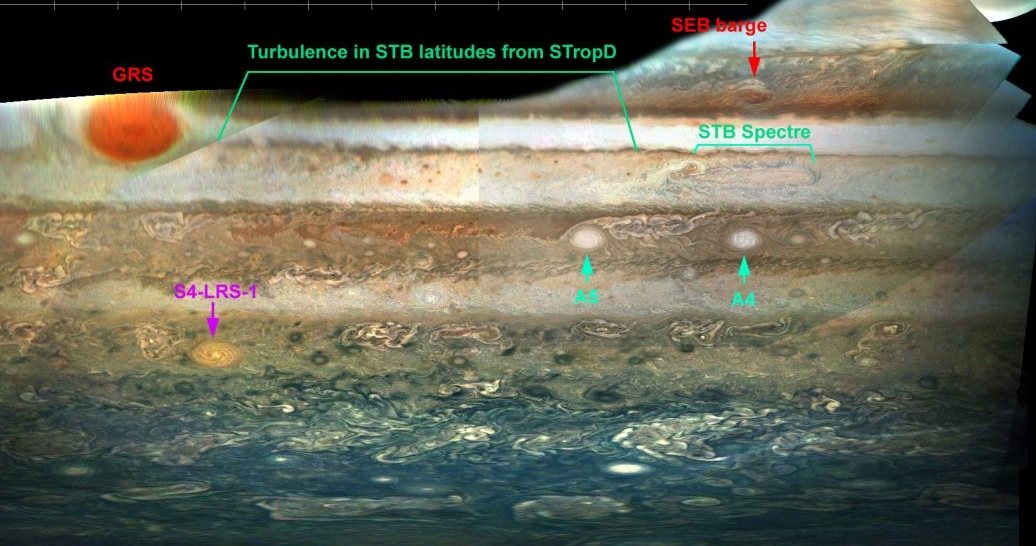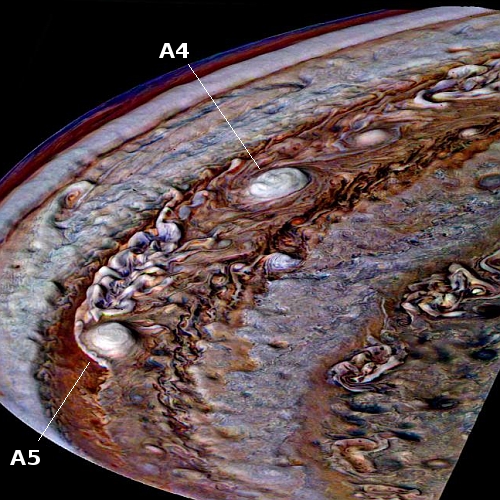A pseudo-oblique view of Jupiter’s cloud-tops
Cool image time! The image to the right, cropped, reduced, and annotated to post here, was created on October 18, 2022 by citizen scientist Thomas Thomopoulos from one of the photos taken by Juno during its close fly-by of Jupiter in May 2018.
He created this three dimensional relief by assigning different elevation values across the image’s greyscale, with white having the highest elevation. This relief is thus not based on actual topography, but it provides a nice way to illustrate the cloud structures of Jupiter’s cloud tops. It also, as Thomopoulos notes, provide a good way to possibly “see a representation in relief of surface movements.” Nor is his topography based on greyscale far wrong, since in many Jupiter images the lighter colored clouds are generally higher because the darker ones are in shadow.
The map below provides the context and scale of this image.

Click for full map.
The map above, cropped to show here, was produced by John Rogers (of the British Astronomical Association) and citizen scientist Gerald Eichstädt, and was part of a more detailed report [pdf] of all the images taken by Juno during that May 2018 fly-by. It shows the part of Jupiter’s southern hemisphere that Juno saw.
Based on the estimated 9,800 mile diameter of the Great Red Spot (GRS), I estimate that A5 is about 3,000 miles across, while A4 is about 2,500 miles across, which means both storms are big enough to cover the entire continental United States. A5 looks smaller in the image above because of distortion created during image processing.
On Christmas Eve 1968 three Americans became the first humans to visit another world. What they did to celebrate was unexpected and profound, and will be remembered throughout all human history. Genesis: the Story of Apollo 8, Robert Zimmerman's classic history of humanity's first journey to another world, tells that story, and it is now available as both an ebook and an audiobook, both with a foreword by Valerie Anders and a new introduction by Robert Zimmerman.
The print edition can be purchased at Amazon or from any other book seller. If you want an autographed copy the price is $60 for the hardback and $45 for the paperback, plus $8 shipping for each. Go here for purchasing details. The ebook is available everywhere for $5.99 (before discount) at amazon, or direct from my ebook publisher, ebookit. If you buy it from ebookit you don't support the big tech companies and the author gets a bigger cut much sooner.
The audiobook is also available at all these vendors, and is also free with a 30-day trial membership to Audible.
"Not simply about one mission, [Genesis] is also the history of America's quest for the moon... Zimmerman has done a masterful job of tying disparate events together into a solid account of one of America's greatest human triumphs."--San Antonio Express-News
Cool image time! The image to the right, cropped, reduced, and annotated to post here, was created on October 18, 2022 by citizen scientist Thomas Thomopoulos from one of the photos taken by Juno during its close fly-by of Jupiter in May 2018.
He created this three dimensional relief by assigning different elevation values across the image’s greyscale, with white having the highest elevation. This relief is thus not based on actual topography, but it provides a nice way to illustrate the cloud structures of Jupiter’s cloud tops. It also, as Thomopoulos notes, provide a good way to possibly “see a representation in relief of surface movements.” Nor is his topography based on greyscale far wrong, since in many Jupiter images the lighter colored clouds are generally higher because the darker ones are in shadow.
The map below provides the context and scale of this image.

Click for full map.
The map above, cropped to show here, was produced by John Rogers (of the British Astronomical Association) and citizen scientist Gerald Eichstädt, and was part of a more detailed report [pdf] of all the images taken by Juno during that May 2018 fly-by. It shows the part of Jupiter’s southern hemisphere that Juno saw.
Based on the estimated 9,800 mile diameter of the Great Red Spot (GRS), I estimate that A5 is about 3,000 miles across, while A4 is about 2,500 miles across, which means both storms are big enough to cover the entire continental United States. A5 looks smaller in the image above because of distortion created during image processing.
On Christmas Eve 1968 three Americans became the first humans to visit another world. What they did to celebrate was unexpected and profound, and will be remembered throughout all human history. Genesis: the Story of Apollo 8, Robert Zimmerman's classic history of humanity's first journey to another world, tells that story, and it is now available as both an ebook and an audiobook, both with a foreword by Valerie Anders and a new introduction by Robert Zimmerman.
The print edition can be purchased at Amazon or from any other book seller. If you want an autographed copy the price is $60 for the hardback and $45 for the paperback, plus $8 shipping for each. Go here for purchasing details. The ebook is available everywhere for $5.99 (before discount) at amazon, or direct from my ebook publisher, ebookit. If you buy it from ebookit you don't support the big tech companies and the author gets a bigger cut much sooner.
The audiobook is also available at all these vendors, and is also free with a 30-day trial membership to Audible.
"Not simply about one mission, [Genesis] is also the history of America's quest for the moon... Zimmerman has done a masterful job of tying disparate events together into a solid account of one of America's greatest human triumphs."--San Antonio Express-News



Are there any plans to land something on Jupiter? Is that even possible? The gravitational pull of Jupiter – does that make it impossible for an orbiting probe to ever leave that orbit?
Steve Richter: Jupiter has no solid surface as we’d know it. Below the clouds the atmosphere becomes a hydrogen-helium blend, and it gets denser and hotter as you go deeper. But it is always a fluid. Eventually the conditions exceed anything we can build to withstand it.
The Galileo probe had an atmospheric probe that dropped down into and below the clouds. Check out the “Planetery Data Base” for those data. Eventually the probe failed for the heat and pressure.
Leaving a Jupiter orbit is not impossible, but it takes a sizable boost compared to earth. Probes like Galileo and Juno are in highly elliptical orbits. They are easier to break free from the planet with a relatively smaller boost than would be from a circular orbit. And it always depends on how far away you are at “perijove” – the closest approach in an orbit. The further away you are, the easier it is to break free.
Mr. Zimmerman, I am continuously amazed by the imagery that turns up on this web site. This cloud-top picture of Jupiter, even if massively computer-enhanced to appear 3D is simply stunning. Thank you for taking the time to run this web site and post this material.
I also appreciate your “today’s blacklisted by collectivist” posts.
Best Regards.
Blackwing1: Thank you for your kind words. I write about subjects that either interest me, or my mind considers too important to ignore. Thus, my eclectic tastes, which do not fit into any obvious mold.
Some might be bothered by this. I say, freedom means each person follows the path that works for them. And when I see anyone trying to squelch that freedom, I get very angry. Which is why I write the blacklist column, and constantly express my sad but deep contempt for today’s Democratic Party.
David Telford-
Thanks for those concise factoids!
Q: What is the ‘escape velocity’ for Jupiter?
And… can I assume there is an ideal ‘closest stable-orbit?’
wayne,
Try the following chart:
https://i.imgur.com/SqdzxzF.png
Adding up the various delta-v numbers along the Jupiter path gives an escape delta-v of 17.2 km/s from a 2,000 km orbit (probably circular). Since the escape velocity from a circular orbit is the square root of two times the circular orbital velocity, this gives an escape velocity of 24.3 km/s.
I suspect that there are lower stable orbits, but your use of the word “ideal” throws me off, because “ideal” could be different for different missions. For instance, the Juno probe’s ideal orbit is different than for the Galileo probe (It is also lower than its current orbit, but engine troubles caused NASA to leave it in the more eccentric orbit that it is in now.)